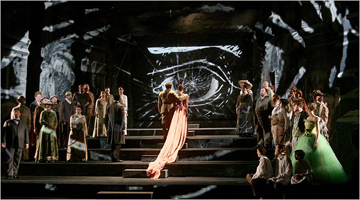Among the elements explored in Art21’s William Kentridge: Anything is Possible, the film looks at his many influences, from his personal background to his love of the performing arts. What better way to celebrate the film than to dedicate the topic of the next Flash Points to the subject of Influence and the various forms this can take in an artist’s work?
Our particular backgrounds shape how we interpret the world around us. Kentridge says in the film, “I think there has to be a fundamental insistence of having to leave a kind of snail trail behind of who one is and what one’s been.” For him, this consists of a country dealing with the effects and aftermath of apartheid, the legacy of which is steeped in his art. His hometown of Johannesburg and the political climate of South Africa make appearances throughout, as does the artist himself, specifically in the physical resemblance of his two main characters, Soho and Felix. His work is imbued with a sense of self. Similarly, in addition to Kentridge, artists such as Sally Mann or Louise Bourgeois are strongly influenced by their family and backgrounds, drawing from these experiences to shape their work. As Ms. Bourgeois stated, “My childhood has never lost its magic, it has never lost its mystery, and it has never lost its drama.”

A scene from William Kentridge's production of "The Magic Flute," the Brooklyn Academy of Music. Photo by Julien Jourdes for The New York Times.
Beyond the cultural and personal, we’ll look at how other forms of art and artists themselves can be great sources of inspiration. In Kentridge’s case, his artistic perspective was influenced by his art historical predecessors. Russian modernists Kazimir Malevich and Vladimir Tatlin shaped his definition of political art, and references to Picasso, Beuys, and Goya (to name a few) can be found in his work, 7 Fragments for Georges Melies. Kentridge is heavily influenced by other art forms as well, merging the performing, literary, and visual arts in projects such as The Nose, his interpretation of Dmitri Shostakovich’s opera, which is based on the short story by Nikolai Gogol. Involvement with the performing arts was a childhood dream of his, and “this was the closest I’ve got back to [my] early ambition of working with opera.” Artists such as Bill Viola or Laurie Anderson work in a similar vein, engaging in projects that bridge the gap between the performing and visual arts, creating an artistic hybrid that’s mutually influenced by these worlds.
Kentridge’s love of the stage was fostered by early theatrical and mime classes in Paris, forever shaping his work as an artist. We’ll explore the role that institutions play in an artist’s growth, from the courses and mentorships fostered in art school, to the relationships developed during the exhibition process with a museum or gallery, and how these affect the evolution of the project.
There are myriad influences on how an artist approaches his or her creative process. Here are a few of the questions we’ll be addressing over the coming months. We’d love to hear your own thoughts and ideas in the comments below:
- What is the impact of outside influences on an artist’s work?
- How does an artist’s background inform his or her work, and how does our experience as a viewer inform our understanding of it?
- What kind of impact do art education programs or mentorships have on an artist?
- How are artists influenced by each other or by other forms of art?
- How do institutions play a role in an artist’s development?




Pingback: Art Under the Influence | Art21 Blog